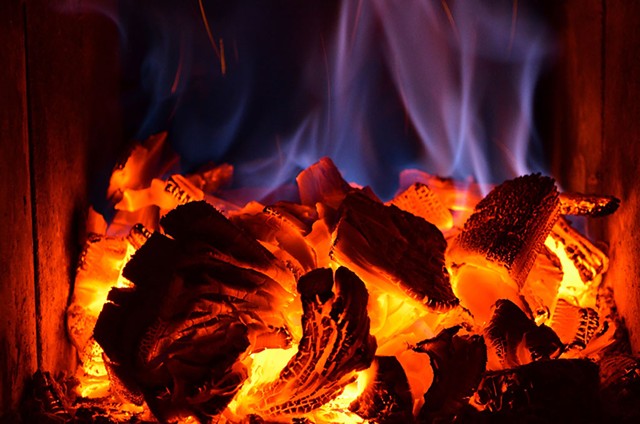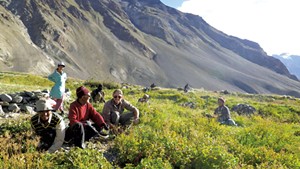
- Dreamstime
Jonathan Mingle writes chillingly about how black carbon is causing health problems and melting glaciers in the Himalayas. He also notes that the little-known pollutant — a component of soot that results from incomplete combustion — isn't exclusively a faraway problem. Wildfires in the western United States, for instance, produce black carbon that hastens glacial melting in the Arctic.
After Fire and Ice came out, a taken-aback reader wrote to the Vermont author, swearing off campfires. Which raises the question: How concerned should we be about black carbon in our own backyard?
"We haven't figured out our soot problem completely," Mingle says in a phone interview. "But if you look at our nation as a whole, it looks pretty clean."
In Vermont, the good news is that there aren't any glaciers downwind. But that doesn't mean we can burn with abandon — we still have our lungs to look after.
Unlike many of the people Mingle writes about, Vermonters don't generally cook indoors over open fires fueled by yak dung. But in the Green Mountain State, where winters are frigid and forests abundant, we are prolific burners of wood. In fact, the Environmental Protection Agency released data last year showing that Vermonters produce the most emissions from burning wood per capita — 22 pounds, which is nearly double the figure for second-place Wisconsin.
How much of those emissions is black carbon is unclear. Neither Vermont nor the EPA monitors black carbon specifically; instead, they track "fine particle" emissions, a potpourri of pollutants that includes black carbon. A 2002 study by the EPA identified residential wood burning as the major source of fine particles in Vermont.
As much as half of Vermont's population, according to a state Agency of Natural Resources estimate, heats its homes with woodstoves. But there's a big difference between old models — manufactured before 1988, when the EPA passed requirements limiting emissions — and new ones. Last year, the federal agency put in place even stricter limits for stoves and for the hitherto unregulated wood-heated boilers. The new rules are being phased in starting this year, but they don't apply to products already on the market.
Local stove manufacturers objected to those regulations, but state officials have maintained that they'll substantially reduce emissions.
Mingle approves, too, but he predicts the turnover rate of people swapping old stoves for new ones will be slow. One way to expedite the process: a cash-for-clunkers program in which the state offers financial incentives to get people to upgrade. Vermont currently has no such program for woodstoves; it did have one for outdoor wood boilers, which was suspended last September.
Another approach, Mingle suggests, is to regulate the sale of used stoves. That hasn't happened, either.
And what about the mega-wood incinerators such as Burlington's Joseph C. McNeil Generating Station, a biomass plant that produces roughly enough electricity to power the entire city?
According to officials in the state Department of Environmental Conservation's Air Quality & Climate Division, McNeil does release some fine particles, but substantially fewer than does residential wood-burning.
Dave MacDonnell, Burlington Electric Department's director of generation, explains that's because the plant employs several technologies, including something called an electrostatic precipitator, that remove particles from the exhaust gas. "When I looked first thing this morning, we were at zero percent opacity," MacDonnell says with pride — meaning that essentially no particles were escaping through the smokestack.
It's not just local power plants that people need to worry about; in 2012, Vermont was one of a handful of states that sued the EPA over soot pollution originating in out-of-state coal plants.
Nationally, diesel fuel is the largest source of black carbon. Here, too, new technology has made a big difference, reducing the pollutants that diesel engines emit. Vermont goes farther than the federal government, requiring that new cars and trucks sold in the state meet the higher emissions standards set by California.
But, as with stoves, the persistence of old models remains a problem. "If your neighbor has an old diesel clunker that he idles for 40 minutes in the winter" — particularly when there's no wind to disperse the pollutants — your lungs could suffer, Mingle suggests.
Before immersing himself in studying the dangers of black carbon, the author actually owned a 1985 Mercedes Benz station wagon that ran on diesel. (When possible, he filled up with vegetable oil.)
Mingle points to a particularly troubling source: school buses. According to the ANR, more than 1,800 diesel-powered buses transport some 75,000 children per year in Vermont. Both the state and the EPA have programs to help pay for new buses, although Mingle thinks they could use more funding.
His overall assessment of the local health impact of black carbon: "It's significant only if you live and work and go about your daily business in the vicinity of a source that's not well controlled. That could be an old woodstove burning green wood. Or it could be a piece of diesel construction equipment that's working at your neighbor's place for months."
Jeffrey Merrell, an environmental analyst with the state's Air Quality & Climate Division, puts it this way: Vermont has made "significant progress," but black carbon "still presents a public health concern in certain areas and at certain times."
To the man concerned about campfires, Mingle recommended a less extreme approach: Stay upwind.










Comments
Comments are closed.
From 2014-2020, Seven Days allowed readers to comment on all stories posted on our website. While we've appreciated the suggestions and insights, right now Seven Days is prioritizing our core mission — producing high-quality, responsible local journalism — over moderating online debates between readers.
To criticize, correct or praise our reporting, please send us a letter to the editor or send us a tip. We’ll check it out and report the results.
Online comments may return when we have better tech tools for managing them. Thanks for reading.